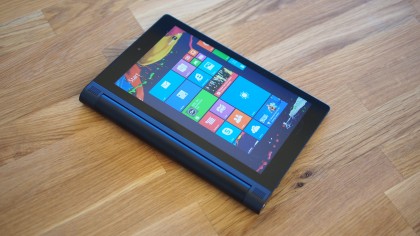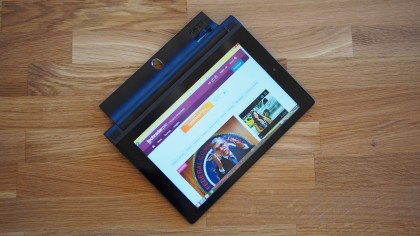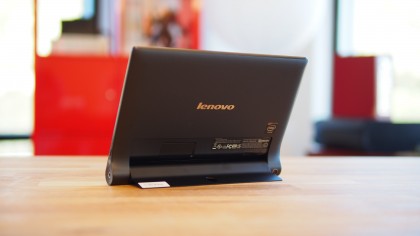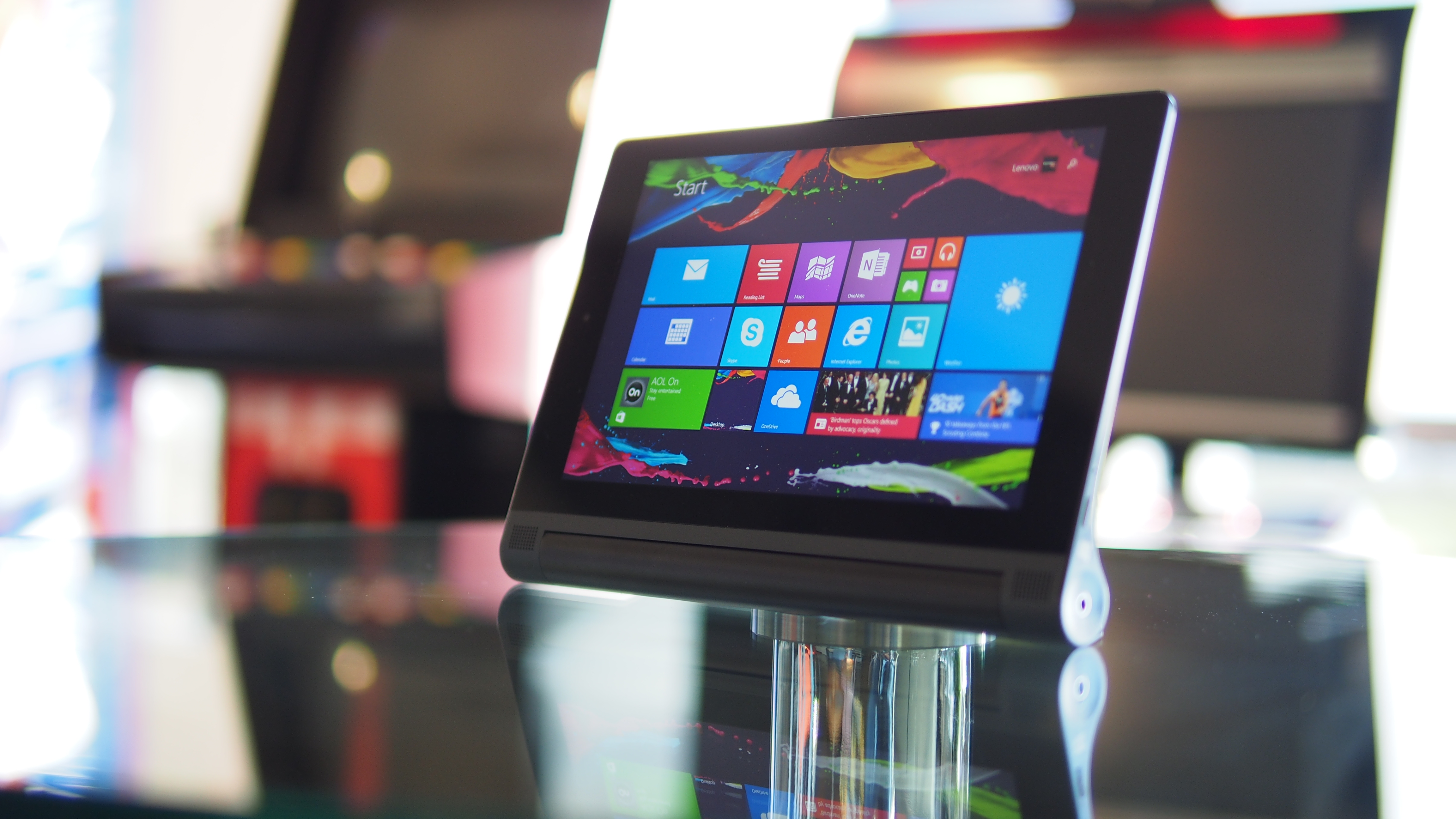TechRadar Verdict
Lenovo's Yoga Tablet 2 with AnyPen is a capable Windows 8 tablet, if you're willing to live in the confines of an 8-inch window. Though lacking a full USB port and HDMI-out, this slate offers great ergonomics and long battery life.
Pros
- +
Excellent build quality
- +
Lengthy battery life
- +
Fun AnyPen technology
- +
Ergonomics
Cons
- -
Using 'any pen' is a liability
- -
No video output
- -
No USB port
- -
Limited storage
Why you can trust TechRadar
Capitalizing on the stylus craze to give tablet owners more precision input, Lenovo asks users of its $299 (£195, AU$385) Yoga Tablet 2 with Windows to not only touch and poke at the screen, but to key it, stab it, and slash it with almost any metal object. Though Lenovo is merely iterating on its Yoga Tablet design, the real highlight - and really what distinguishes the tablet from others in the crowded space - is its AnyPen technology.
With AnyPen, the Yoga Tablet 2 owners benefit from the finer accuracy of a digital stylus, but with the convenience of being able to use most everyday objects as a pen. Rather than carrying a specialized digital inking device that could get lost or stolen, AnyPen lets you create your own makeshift stylus.
Lenovo hopes that the convenience of AnyPen will help the Yoga Tablet 2 command a premium price. The Yoga Tablet 2 is priced higher than the $150 (£100, AU$195) 8-inch Dell Venue 8 Pro with an optional Active Stylus, but Dell's advantage is that you can add a folio and compact keyboard with physical keys to turn the slate into a netbook. Those who prefer Android and need pen-enabled support can opt for the $330 (£215, AU$425) Samsung Galaxy Note 8.
Without stylus support, pricing for Windows tablets with screens eight-inch or under drop to below $200 (£130, AU$260). Options in this spectrum include the $149 (£100, AU$190) Asus VivoTab 8, the $79 (£55, AU$100) 7-inch HP Stream 7 , and the $179 (£115, AU$230) HP Stream 8 with a built-in 4G modem. If you're happy with iOS, Apple's $399 (£260, AU$510) iPad mini 3 is a great choice.
Design
Measuring 8.27 x 5.87 x 0.28 inches or 210 x 149 x 7 mm (W X L X H), the Yoga Tablet 2 is an extension of Lenovo's Yoga vision in offering customers a single device that transforms into different form factors.

Like the first generation Yoga Tablet, the Tablet 2 with Windows sheds the 360-degree hinged keyboard from Lenovo's Yoga Ultrabook series. Cloaked in black, you're presented with the familiar slim design, barreled edge that is home to a flip-out kickstand (and the battery inside), and metal flourishings. Although the sides, barrel, and kickstand are constructed from metal, the backside is made of textured, matte plastic.
A crisp 8-inch, full HD, 1080p IPS display graces the front of the tablet. Because of the barreled edge, the tablet feels more balanced in landscape mode when used on a flat surface. In this position, the rear of the tablet is elevated while the front edge is lower, making it more comfortable to look down on the screen when you're sitting at your desk and easier to type on the touchscreen.
Sign up to the TechRadar Pro newsletter to get all the top news, opinion, features and guidance your business needs to succeed!

In portrait mode on a desk, the barrel creates an elevated spine that prevents the tablet from fully laying flat. As a result, you're left with an inclined side, which is fine for casual web surfing and reading, but makes typing awkward.
To make the tablet slim, Lenovo relies on the barrel for several functions. The barrel houses a pair of front-facing, Dolby-tuned speakers. As this is the thickest point on the tablet, it provides more space for the speakers to produce richer sound.
The battery is housed in the barrel as well to keep the overall tablet slim. Lenovo also placed the rear 8-megapixel camera on the barrel. Additionally, the barrel serves as a hinge to stow the mechanical kickstand.

The metal kickstand is activated when you apply force to push down. This opens up the kickstand and you can then pry the stand fully open. The kickstand allows the tablet to be used in four modes.
According to Lenovo, with the stand closed, you can hold it like a tablet. With the stand engaged, you can stand it up similar to the larger Microsoft Surface Pro 3. You can tilt the tablet on a desk, so it's propped up for easier viewing and more comfortable on-screen typing.
Finally, you can fully open the stand, revealing a small hole in the center of the kickstand that allows you to hang the tablet. This last mode is great if you want to to hang the tablet in a workspace so you can watch videos or multitask.

As a tablet, the barrel also serves an ergonomic purpose, making the Yoga Tablet 2 with Windows comfortable to hold for long periods of time. In use, it feels like wrapping the cover of a paperback book around the spine.
Coupled with the tablet's light 0.94-pound (0.43kg) weight, it makes for a very pleasant companion to read an e-book on the couch or in bed. However, magazines, PDFs, and larger format materials will feel cramped on an 8-inch screen with a 16:9 aspect ratio.
The weight of the Yoga Tablet 2 with Windows is comparable to the 0.87-pound (0.39kg) Dell Venue 8 Pro, and is about the same weight as the 0.96-pound (0.44kg) iPad Air 2, though Apple's device has a larger 9.7-inch display. The nice thing about the Lenovo slate is that it feels balanced; when holding the tablet in bed, I never felt like the tablet would fall and smack me in the face.
The Yoga Tablet 2 comes with a minimum array of buttons and ports. Neatly fit on one end of the barrel is a circular power button. The button is surrounded by an LED ring, which lights up when the tablet is plugged in for charging.

The other end of the barrel is home to a 3.5mm headphone jack. A slim Windows button sits on the tablet's bezel, along with a single micro USB port and volume rocker on its side.
Unlike many other Windows slates, the placement of the Windows Start button on the side of the tablet makes it awkward, especially when used in portrait mode. For right-handed users holding the slate in their left hand, the Start button will be on the bottom edge of the device, making it difficult to reach.
